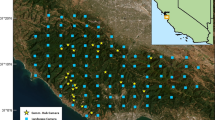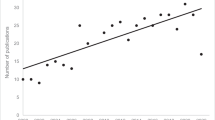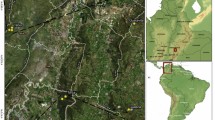Abstract
Geophagy occurs in all primate groups and is particularly common in species that consume greater quantities of plant material, i.e., leaves, fruit. The function of geophagy is not fully understood and likely varies over space and time, perhaps in connection with changes in diet. Central to a better understanding of geophagy in primate ecology is knowledge of the occurrence of such behavior among different species and seasons. We used camera traps triggered by heat and motion to document the use of mineral licks by primates over a 3-yr period at a lowland forest site in eastern Ecuador (Tiputini Biodiversity Station). Such mineral licks can be important sources of minerals, nutrients, and other compounds for a wide range of species in Amazonian forests. Although 10 species of primates are known from the study site, we obtained photographs of only 2 species, Ateles belzebuth (white-bellied spider monkey) and Alouatta seniculus (red howler) at 2 of 4 saladeros surveyed. From late December 2004 through early January 2008, we recorded 192 photographs with a total of 318 Ateles belzebuth representing ≥66 separate visits. Comparable numbers for Alouatta seniculus were 80, 121, and 37. We recorded both species visiting a mineral lick at the same time on ≥7 occasions. Use of mineral licks varied across months; we recorded more visits from November through February, the drier period at Tiputini. Visits also varied by hour, with no visits before 0830 or after 1630; Ateles belzebuth showed a stronger mid-day peak in visits. Average visit length (calculated as the time between the first and last photographs of a given visit) was similar between the 2 species but median visit length was more than twice as long for Ateles belzebuth (15 min) as for Alouatta seniculus (6 min). Results indicate that mineral licks are important in the ecology of these species, but further studies are needed to determine the precise benefit(s) obtained and how benefits may vary with diet and other factors.



Similar content being viewed by others
References
Abrahams, P. W., & Parsons, J. A. (1996). Geophagy in the tropics: a literature review. Geographical Journal, 162, 63–72.
Analytical Software. (2003). Statistix 8. Tallahassee: Analytical Software.
Atwood, T. C., & Weeks, H. P., Jr. (2002). Sex- and age-specific patterns of mineral lick use by white-tailed deer (Odocoileus virginianus). American Midland Naturalist, 148, 289–296.
Atwood, T. C., & Weeks, H. P., Jr. (2003). Sex-specific patterns of mineral lick preference in white-tailed deer. Northeastern Naturalist, 10, 409–414.
Bicca-Marques, J. C., & Calegaro-Marques, C. (1994). A case of geophagy in the black howling monkey Alouatta caraya. Neotropical Primates, 2, 7–9.
Brightsmith, D. J. (2004). Effects of weather on parrot geophagy in Tambopata, Peru. Wilson Bulletin, 116, 134–145.
Brightsmith, D., & Muñoz-Najar, R. (2004). Avian geophagy and soil characteristics in southeastern Peru. Biotropica, 36, 534–543.
Britt, A., Randriamandratonirina, J. J., Glasscock, K. D., & Iambana, B. R. (2002). Diet and feeding behavior of Indri indri in a low-altitude rain forest. Folia Primatologica, 73, 225–239.
Burger, J., & Gochfeld, M. (2003). Parrot behavior at a Rio Manu (Peru) clay lick: temporal patterns, associations, and antipredator responses. Acta Ethologica, 6, 23–34.
Campbell, C. J., Aureli, F., Chapman, C. A., Ramos-Fernández, G., Matthews, K., Russo, S. E., et al. (2005). Terrestrial behavior of Ateles spp. International Journal of Primatology, 26, 1039–1051.
Clayton, L., & Macdonald, D. W. (1999). Social organization of the babirusa (Babyrousa babyrussa) and their use of salt licks in Sulawesi, Indonesia. Journal of Mammalogy, 80, 1147–1157.
Davies, A. G., & Baillie, I. C. (1988). Soil-eating by red leaf monkeys (Presbytis rubicunda) in Sabah, northern Borneo. Biotropica, 20, 252–258.
de la Torre, S. (2000). Primates de la Amazonía del Ecuador/Primates of Amazonian Ecuador. Quito: SIMBIOE.
De Souza, L. L., Ferrari, S. F., Da Costa, M. L., & Kern, D. C. (2002). Geophagy as a correlate of folivory in red-handed howler monkeys (Alouatta belzebul) from eastern Brazilian Amazonia. Journal of Chemical Ecology, 28, 1613–1621.
Defler, T. R. (2004). Primates of Colombia. Conservation International – tropical field guide series. Chicago: University of Chicago Press.
Dew, J. L. (2005). Foraging, food choice, and food processing by sympatric ripe-fruit specialists: Lagothrix lagotricha poeppigii and Ateles belzebuth belzebuth. International Journal of Primatology, 26, 1107–1135.
Di Fiore, A. G. (2002). Predator sensitive foraging in ateline primates. In L. E. Miller (Ed.), Eat or be eaten: Predator sensitive foraging among primates (pp. 242–267). Cambridge: Cambridge University Press.
Di Fiore, A., & Suarez, S. A. (2007). Route-based travel and shared routes in sympatric spider and wooly monkeys: cognitive and evolutionary implications. Animal Cognition, 10, 317–329.
Diamond, J., Bishop, K. D., & Gilardi, J. D. (1999). Geophagy in New Guinea birds. Ibis, 141, 181–193.
Dominy, N. J., Davoust, E., & Minekus, M. (2004). Adaptive function of soil consumption: an in vitro study modeling the human stomach and small intestine. Journal Experimental Biology, 207, 319–324.
Emmons, L. H. (1997). Neotropical rainforest mammals. A field guide (2nd ed.). Chicago: University of Chicago Press.
Emmons, L. H., & Stark, N. M. (1979). Elemental composition of a natural mineral lick in Amazonia. Biotropica, 11, 311–313.
Ferrari, S. F., Veiga, L. M., & Urbani, B. (2008). Geophagy in New World monkeys (Platyrrhini): ecological and geographic patterns. Folia Primatologica, 79, 402–415.
Gilardi, J. D., Duffey, S. S., Munn, C. A., & Tell, L. A. (1999). Biochemical functions of geophagy in parrots: detoxification of dietary toxins and cytoprotective effects. Journal Chemical Ecology, 25, 897–922.
Heyman, E. W., & Hartmann, G. (1991). Geophagy in moustached tamarins, Saguinus mystax (Platyrrhini: Callitrichidae), at the Río Bravo, Peruvian Amazonia. Primates, 32, 533–537.
Izawa, K. (1993). Soil-eating by Alouatta and Ateles. International Journal of Primatology, 14, 229–242.
Izawa, K., & Lozano, M. H. (1990). Frequency of soil-eating by a group of wild howler monkeys (Alouatta seniculus) in La Macarena, Colombia. Field Studies New World Monkeys, La Macarena Colombia, 4, 47–56.
Karubian, J., Fabara, J., Yunes, D., Jorgenson, J. P., Romo, D., & Smith, T. B. (2005). Temporal and spatial patterns of macaw abundance in the Ecuadorian Amazon. Condor, 107, 617–626.
Ketch, L. A., Malloch, D., Mahaney, W. C., & Huffman, M. A. (2001). Comparative microbial analysis and clay mineralogy of soils eaten by chimpanzees (Pan troglodytes schweinfurthii) in Tanzania. Soil Biology & Biochemistry, 33, 199–203.
Kreulen, D. A. (1985). Lick use by large herbivores: a review of benefits and banes of soil consumption. Mammal Review, 15, 107–123.
Krishnamani, R., & Mahaney, W. C. (2000). Geophagy among primates: adaptive significance and ecological consequences. Animal Behaviour, 59, 899–915.
Lizcano, D. J., & Cavelier, J. (2000). Daily and seasonal activity of the mountain tapir (Tapirus pinchaque) in the Central Andes of Colombia. Journal of Zoology, 252, 429–435.
Lizcano, D. J., & Cavelier, J. (2004). Chemical characteristics of salt licks and feeding habits of mountain tapir (Tapirus pinchaque) in the Central Andes of Colombia. Maztozoologia Neotropical, 11, 193–201.
Mahaney, W. C., Aufreiter, A., & Hancock, R. G. V. (1995). Mountain gorilla geophagy: a possible seasonal behavior for dealing with the effects of dietary changes. International Journal Primatology, 16, 475–488.
Mahaney, W. C., Milner, M. W., Sanmugadas, K., Hancock, R. G. V., Aufreiter, S., Wrangham, S., et al. (1997). Analysis of geophagy soils in Kibale Forest, Uganda. Primates, 38, 159–176.
Matsubayashi, H., Lagam, P., Majalap, N., Tangah, J., Sukon, J. R. A., & Kitayama, K. (2007). Importance of natural licks for the mammals in Bornean inland tropical rain forests. Ecological Research, 22, 742–748.
Matsuda, I., & Izawa, K. (2008). Predation of wild spider monkeys at La Macarena, Colombia. Primates, 49, 65–68.
Müller, K.-H., Ahl, C., & Hartmann, D. G. (1997). Geophagy in masked titi monkeys (Callicebus personatus melanochir) in Brazil. Primates, 38, 69–77.
Norconk, M. A., Wertis, C., & Kinzey, D. W. G. (1997). Seed predation by monkeys and macaws in eastern Venezuela: preliminary findings. Primates, 38, 177–184.
Norscia, I., Carrai, V., Ceccanti, B., & Borgognini Tarli, S. M. (2005). Termite soil eating in kirindy sifakas (Madagascar): proposing a new proximate factor. Folia Primatologica, 76, 119–122.
Pages, G., Lloyd, E., & Suarez, S. A. (2005). The impact of geophagy on ranging behavior in Phayre’s leaf monkeys (Trachypithecus phayrei). Folia Primatologica, 76, 342–346.
Robinson, J. G. (1984). Diurnal variation in foraging and diet in the wedge-capped capuchin Cebus olivaceus. Folia Primatologica, 43, 216–228.
Russo, S. E., Campbell, C. J., Dew, J. L., Stevenson, P. R., & Suarez, S. A. (2005). A multi-forest comparison of dietary preferences and seed dispersal by Ateles spp. International Journal Primatology, 26, 1017–1037.
Schmitz, C. A., Di Fiore, A., Link, A., Matthews, L. J., Montague, M. J., Derby, A. M., et al. (2007). Comparative ranging behavior of eight species of primates in a western Amazonian rainforest [Abstract]. American Journal Physical Anthropology (Supplement), 44, 208–209.
Setz, E. Z. F., Enzweiler, J., Solferini, V. N., Amêndola, M. P., & Berton, R. S. (1999). Geophagy in the golden-faced saki monkey (Pithecia pithecia chrysocephala) in the Central Amazon. Journal of Zoology, London, 247, 91–103.
SPSS Inc. (2007). SPSS 16.0 for Windows. Chicago: SPSS Inc.
Stevenson, P. R., Quiñones, M. J., & Ahumada, J. A. (2000). Influence of fruit availability on ecological overlap among four neotropical primates at Tinigua National Park, Colombia. Biotropica, 32, 533–544.
Valencia, R., Foster, R. B., Villa, G., Condit, R., Svenning, J.-C., Hernandéz, C., et al. (2004). Tree species distributions and local habitat variation in the Amazon: large forest plot in eastern Ecuador. Journal of Ecology, 92, 214–229.
Veiga, L. M., & Ferrari, S. F. (2007). Geophagy at termitaria by bearded sakis (Chiropotes satanas) in southeastern Brazilian Amazonia. American Journal of Primatology, 69, 816–820.
Voigt, C. C., Dechmann, D. K. N., Bender, J., Rinehart, B. J., Michener, R. H., & Kunz, T. H. (2007). Mineral licks attract neotropical seed-dispersing bats. Research Letters Ecology 2007: article ID 34212, 4 pp. doi:1155/2007/34212.
Voigt, C. C., Capps, K. A., Dechmann, D. K. N., Michener, R. H., & Kunz, T. H. (2008). Nutrition or detoxification: why bats visit mineral licks of the Amazonian rainforest. PLoS, 3(1–4), e2011.
Voros, J., Mahaney, W. C., Milner, M. W., Krishnamani, R., Aufreiter, S., & Hancock, R. G. V. (2001). Geophagy by the bonnet macaques (Macaca radiata) of southern India: a preliminary analysis. Primates, 42, 327–344.
Wakibara, J. V., Huffman, M. A., Wink, M., Reich, S., Aufreiter, S., Hancock, R. G. V., et al. (2001). The adaptive significance of geophagy for Japanese macaques (Macaca fuscata) at Arashiyama, Japan. International Journal of Primatology, 22, 495–520.
Wallace, R. B. (2001). Diurnal activity budgets of black spider monkeys, Ateles chamek, in a southern Amazonian tropical forest. Neotropical Primates, 9, 101–107.
Whitlock, M. C., & Schluter, D. (2009). The analysis of biological data. Greenwood Village: Roberts.
Acknowledgments
We thank the many staff and volunteers who helped check the cameras, particularly Franklin Narvaez, Ramiro San Miguel, and Jose Macanilla. We especially thank Anthony Di Fiore for comments that greatly improved an earlier version of this manuscript and for sharing his knowledge about primates at Tiputini and elsewhere in Amazonia. Two anonymous reviewers also made many helpful suggestions. We also appreciate the help of Consuelo de Romo in facilitating our work at Tiputini and the many staff who help make working there such a pleasure. Support for this study was provided by National Geographic Society (7602-04), Universidad San Francisco de Quito, Tiputini Biodiversity Station, and University of Missouri—St. Louis. We thank Gary Kohout, Snapshot Sniper, LLC, for his help in maintaining the digital cameras.
Author information
Authors and Affiliations
Corresponding author
Rights and permissions
About this article
Cite this article
Blake, J.G., Guerra, J., Mosquera, D. et al. Use of Mineral Licks by White-Bellied Spider Monkeys (Ateles belzebuth) and Red Howler Monkeys (Alouatta seniculus) in Eastern Ecuador. Int J Primatol 31, 471–483 (2010). https://doi.org/10.1007/s10764-010-9407-5
Received:
Accepted:
Published:
Issue Date:
DOI: https://doi.org/10.1007/s10764-010-9407-5




